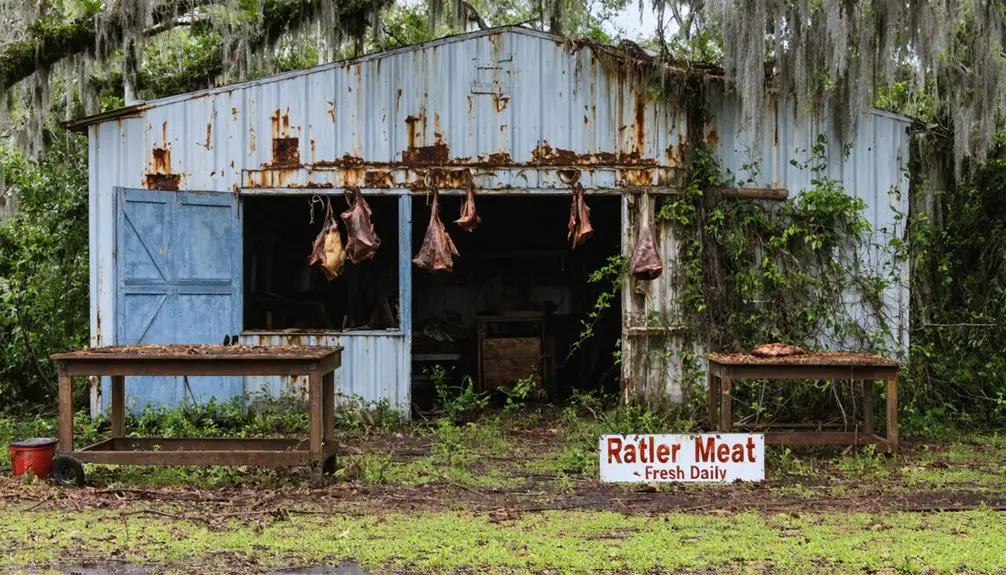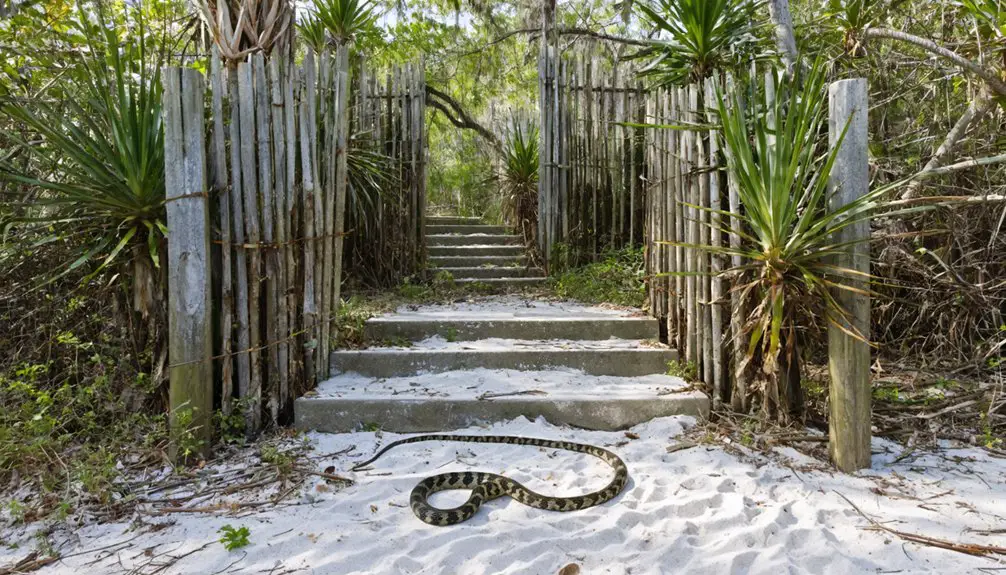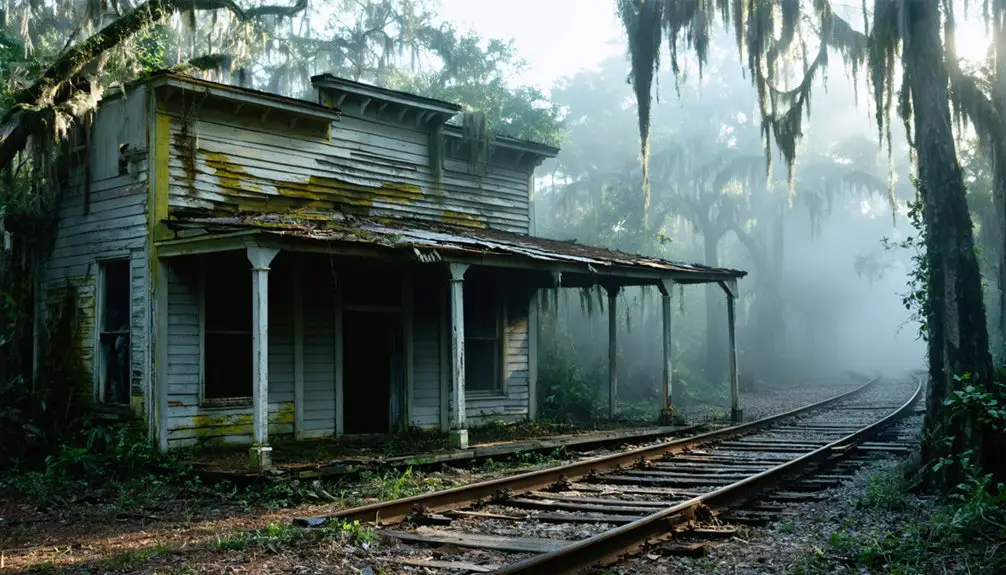You’ll find Rattlesnake, Florida’s unique story began in 1937 when George K. End transformed an abandoned gas station near Tampa into a thriving rattlesnake cannery and tourist attraction. The town centered entirely around the Eastern Diamondback Rattlesnake, with locals earning money by capturing snakes for End’s operation, which produced 15,000 cans annually by 1940. After End’s death from a snakebite in 1944, the town declined rapidly, though its fascinating legacy of snake-based commerce and tourism holds many surprising revelations.
Key Takeaways
- Rattlesnake, Florida emerged in 1937 as a commercial venture centered around processing Eastern Diamondback Rattlesnakes into food products and souvenirs.
- Founder George K. End transformed an abandoned gas station into a thriving rattlesnake cannery that produced 15,000 cans annually by 1940.
- The town featured tourist attractions including snake shows, a general store, snake-milking demonstrations, and its own post office.
- Following End’s death from a snake bite in 1944, the town’s primary industry collapsed, leading to its economic decline.
- Urban expansion from Tampa consumed the former town site, with its post office relocated and renamed Interbay in 1955.
The Birth of a Snake-Centric Community
While many Florida communities emerged around citrus groves or fishing ports, Rattlesnake, Florida developed around a unique natural resource: the Eastern Diamondback Rattlesnake. You’d find these venomous reptiles thriving in the dense pine and palmetto thickets of the Interbay peninsula, with some reaching lengths of 6.5 feet.
In 1937, George K. End transformed this snake-rich environment into a commercial venture, establishing America’s only rattlesnake cannery near Gandy Boulevard. Local residents earned income by capturing snakes for one dollar each. End, a World War I veteran, brought his expertise in taxidermy from Wisconsin to make the venture successful. Though the area never hosted snake-themed festivals or formal reptile conservation efforts, it quickly became a distinctive roadside attraction.
End’s operation included a novelty shop, bar, and the famous “SnakeSnaks” product line. The community gained official recognition with its own post office, making it a legitimate, if unconventional, Florida destination.
George K. End’s Visionary Enterprise
George K. End transformed an abandoned Tampa gas station into Florida’s premier rattlesnake enterprise, pioneering the commercial use of every part of these dangerous reptiles from venom to meat.
His business grew rapidly, reaching annual production of 15,000 cans by 1940.
His flagship product, featuring meat stock and mushrooms, was marketed as a gourmet appetizer for adventurous diners.
You’ll find his marketing genius reflected in his “Subtle Society of Snake Snackers” membership cards and the creation of “SnakeSnaks,” which turned rattlesnake meat into a novelty food attraction.
His visionary venture, though successful in creating a unique niche market and even spawning a named community, ended tragically when he died from a fatal snake bite despite antivenin treatment.
Pioneer of Snake Commerce
During the early 1930s, a pioneering enterprise emerged in Florida when World War I veteran and taxidermist George K. End established a unique rattlesnake business near Arcadia.
You’ll find his venture quickly expanded as he leveraged his biology expertise to revolutionize snake hunting and venom extraction techniques, creating multiple revenue streams from a single reptile.
End’s operation thrived after relocating to Tampa in 1937, where he founded “Rattlesnake, Florida” near Gandy Boulevard.
His innovative product line included “SnakeSnaks” – smoked, salted rattlesnake meat slices – and canned “chicken of the glades.”
He transformed an old gas station into a cannery, novelty shop, and entertainment venue where tourists watched live snake shows.
His business model relied on local hunters supplying Eastern diamondback rattlers, which he processed into food, medicine, and leather goods for nationwide distribution.
Innovative Marketing Techniques
As snake commerce gained momentum in Florida, End revolutionized the industry through ingenious marketing strategies that transformed rattlesnake products into must-have novelties.
His rattlesnake branding created an air of mystique, positioning “chicken of the glades” as both a daring delicacy and nutritious alternative. You’d find his signature canned meat, “Genuine Diamondback Rattlesnake with Supreme Sauce,” marketed at premium prices of $1.25 per can.
End’s novelty marketing prowess shone through his “Subtle Society of Snake Snackers” club, which gave customers exclusive membership cards and a sense of belonging.
He’d draw crowds with live snake-milking demonstrations, turning danger into entertainment. His showmanship, reminiscent of P.T. Barnum, attracted tourists while leveraging military personnel as brand ambassadors.
Through his charismatic promotional style, End transformed a simple cannery into a multi-faceted attraction.
Fatal Business Venture
In 1937, visionary entrepreneur George K. End transformed an abandoned gas station near Tampa into America’s first rattlesnake cannery. He’d moved from Arcadia, Florida, settling on Gandy Boulevard where he built a self-contained community dedicated to all things rattlesnake.
Despite the Great Depression, End’s venture flourished as he marketed canned snake meat, venom, and snake-skin products to soldiers, tourists, and curious locals. His products shipped globally with rattlesnake meat in supreme sauce. The business grew into a thriving community with a general store and restaurant.
The hazardous nature of snake handling eventually proved fatal. End regularly worked with Eastern Diamondbacks exceeding 6.5 feet in length, extracting their venom for both show and commerce.
In 1944, after years of dangerous encounters, a rattlesnake bite claimed End’s life. His death marked the end of his unique enterprise, and the community quickly faded. The post office closed that same year, and Rattlesnake, Florida, began its transformation into a ghost town.
Daily Life in a Serpent Town
Life in Rattlesnake, Florida demanded extraordinary resilience from its inhabitants, who shared their remote commercial outpost with Eastern Diamondback rattlesnakes measuring up to six feet long.
You’d find daily rattlesnake encounters along dirt roads and in the dense pine and palmetto thickets surrounding the town. Community survival centered on the dangerous but profitable snake trade, with workers developing specialized skills in handling venomous reptiles. Local residents frequently spotted four foot rattlers in their yards.
Skilled handlers navigated daily encounters with deadly diamondbacks, making the dangerous snake trade the lifeblood of this remote community.
Unlike traditional towns, you wouldn’t find schools or permanent housing here. Instead, the settlement revolved around its commercial facilities – a post office, general store, gas station, and restaurant.
Your daily routine would’ve involved working at the snake cannery, serving tourists at the snake pit attraction, or operating the novelty shop where rattlesnake products drew curious visitors. The town’s founder met a tragic end when George K. End died from a bite by one of his own snakes.
The Rattlesnake Meat Industry

The rattlesnake meat industry emerged from Rattlesnake’s challenging environment when George K. End, a Wisconsin native and WWI veteran, transformed an overpopulation of serpents into exotic delicacies. Eastern Diamondbacks in the region were known as the most poisonous snake species in America.
After establishing operations in Arcadia in 1931, he relocated to Tampa’s Interbay peninsula in 1937, converting an abandoned gas station into a thriving enterprise. His signature product, “Genuine Diamondback Rattlesnake with Supreme Sauce,” helped establish rattlesnake cuisine as a profitable venture. The canned delicacy featured meat stock and mushrooms that enhanced its flavor.
- Each snake yielded enough meat for three cans, with production reaching 15,000 cans annually by 1940
- Products included “SnakeSnaks,” thin slices of smoked and salted meat named by End’s son
- The meat was marketed as “chicken of the glades” and served in pastry shells
- Every part of the snake was sold, from fangs to meat to venom
- Canned products were shipped nationwide, selling for $1.25 per can
Tourism and Roadside Attractions
While most ghost towns emerged from mining or railroad ventures, Rattlesnake’s unique identity stemmed from its role as a roadside tourist destination centered around George K. End‘s innovative rattlesnake attractions.
During the 1930s and 1940s, you’d find an array of roadside curiosities including a snake pit with live demonstrations, a meat cannery, and a general store selling snake-skin souvenirs.
Located strategically at Gandy Boulevard and Bridge Street, the attraction drew motorists with its mix of entertainment and education. The post office’s “Rattlesnake, Florida” postmark added authenticity to the tourist experience.
Today, while no structures remain, the site evokes tourist nostalgia as a representation of Depression-era entrepreneurship. End’s ironic death by snakebite only enhanced the location’s mystique in Tampa’s cultural memory.
Natural Habitat and Wildlife

You’ll find the ghost town’s rich rattlesnake population thriving in the dense pine and palmetto understory, which provides perfect coverage for eastern diamondbacks and their prey.
The area’s sandy soil composition creates ideal conditions for gopher tortoise burrows, which rattlesnakes frequently use as den sites throughout the year.
The combination of abundant prey species and suitable habitat has led to significant growth in the venomous snake population, particularly the eastern diamondback rattlesnake (Crotalus adamanteus), which dominates the local serpent fauna.
Pine Palmetto Snake Haven
Nestled within Florida’s upland forests, Pine Palmetto Snake Haven features well-drained sandy soils and diverse ecosystems that provide essential habitat for native snake species.
You’ll find a rich tapestry of scrubby flatwoods, dry oak forests, and longleaf pine communities where the Florida pinesnake and other reptiles thrive.
While this snake habitat faces significant conservation challenges, with over 88% of Florida’s scrub habitats lost to development, you can still witness nature’s delicate balance in action.
- Underground burrows and natural cavities serve as critical nesting sites
- Frequent fires maintain open canopy conditions and diverse ground cover
- Gopher tortoise burrows provide shelter for various snake species
- Complex food webs support prey animals like small mammals and amphibians
- Fire-dependent ecosystem requires natural burning cycles to sustain wildlife
Ideal Gopher Burrow Conditions
Since gopher survival depends on precise soil conditions, their burrow systems require specific environmental features to thrive.
You’ll find their ideal gopher habitat in light, porous soils that allow proper gas exchange and maintain structural integrity. These underground architects create burrows 2.5 to 3.5 inches wide, with main tunnels extending up to 200 yards through the earth.
Their complex networks include feeding tunnels 6 to 12 inches deep and nest chambers up to 6 feet below ground. For maximum burrow stability, they need well-draining soils reaching depths of 5-6 feet.
They’ll avoid clay-heavy or waterlogged areas that can collapse or suffocate them. The tunnels feature earthen plugs that regulate temperature and humidity while short, sloping passages facilitate fresh airflow throughout their subterranean domain.
Venomous Species Population Growth
Florida’s diverse ecosystems provide ideal conditions for three distinct rattlesnake species to thrive across the state. From the expansive longleaf pine savannas to the damp bottomlands, you’ll find these venomous snakes adapting to various habitats.
The rattlesnake population benefits from prescribed fires that maintain open forest structures and promote natural prey abundance.
- Eastern Diamondbacks dominate the landscape as Florida’s largest venomous snake, stretching up to 72 inches.
- Timber Rattlesnakes concentrate in 12 northern counties, preferring temperate woodlands.
- Dusky Pygmy Rattlesnakes flourish near swamps and marshes statewide.
- Warm climate and abundant prey support healthy population growth.
- Venomous snake conservation efforts focus on habitat preservation and prescribed burns.
While urban development poses challenges, these adaptable predators continue to maintain ecological balance in both natural and edge environments across Florida’s diverse landscape.
The Town’s Sudden Downfall

When George K. End died from a rattlesnake bite in 1944, the town’s fate was sealed. His refusal to seek proper medical treatment and reliance on outdated antivenom proved fatal, leaving his rattlesnake cannery without visionary leadership.
The economic decline was swift and devastating, as the town’s primary industry shuttered its doors.
You’ll find that urban expansion from Tampa in the post-1940s era dealt the final blow. The original post office was relocated and renamed Interbay in 1955, while construction of the second Gandy Bridge span required demolition of remaining town landmarks.
The transformation of natural snake habitats into residential zones erased the town’s unique character. Without End’s leadership, sustainable revenue streams, or the thousands of Eastern Diamondbacks that once defined the area, Rattlesnake faded into Tampa’s growing metropolis.
Modern-Day Traces and Memories
Though most physical remnants of Rattlesnake have vanished, you’ll still find traces of this peculiar Florida ghost town in Tampa’s modern landscape.
Hidden beneath Tampa’s modern veneer lies Rattlesnake, a ghost town whose echoes still whisper through the streets.
As urban folklore and cultural nostalgia preserve its memory, the area’s transformation from snake-filled wilderness to bustling cityscape tells a uniquely Floridian tale.
- The 1955 Imperial Gas Station replaced the original post office during Gandy Bridge’s expansion
- George K. End’s former cannery site became home to West Shore Club Apartments
- The neighborhood name “Rattlesnake” persists on local maps and in Tampa vernacular
- Historical articles and blogs keep the “SnakeSnaks” story alive through oral histories
- Local museum exhibits showcase the community’s snake-based commerce and End’s tragic death by snakebite
Frequently Asked Questions
What Safety Measures Were in Place to Protect Workers From Snake Bites?
You’d protect yourself from snake bites by wearing thick gloves and sturdy clothing, using tongs to handle snakes, working in controlled environments, having antivenom readily available, and following strict safety protocols.
How Many Snake-Bite Incidents Occurred During the Town’s Active Years?
You’ll find only one confirmed snake-bite incident in historical records – George K. End’s fatal bite in 1944. Unfortunately, snake bite statistics from the town’s earlier years weren’t formally documented.
What Happened to the Remaining Snakes After the Town’s Closure?
You’ll find that Tampa’s urban expansion decimated the snake population dynamics through habitat destruction. The ecological impact was severe – snakes either died off or dispersed as construction replaced their pine-palmetto habitats.
Did Any Other Businesses Attempt to Revive the Snake Industry Afterward?
You won’t find evidence of snake farming revival attempts after End’s death in 1944. Economic challenges, declining rattlesnake populations, and growing wildlife conservation concerns prevented any new commercial snake ventures in Tampa.
How Did Local Native American Tribes View the Commercial Snake Operation?
While direct records don’t exist, you’ll find tribal beliefs likely opposed the operation, as rattlesnakes held deep cultural significance. Native Americans viewed them as sacred creatures rather than commercial commodities.
References
- http://d21c.com/OU812/rattlesnake.html/rattlesnakeflhistory.html
- https://www.florida-backroads-travel.com/rattlesnake-florida.html
- https://en.wikipedia.org/wiki/Rattlesnake_(Tampa)
- https://www.tampabay.com/features/rattlesnake-was-king-and-antivenin-was-near-in-1930s-tampa/1257966/
- http://d21c.com/OU812/rattlesnake.html/rattlesnakefl2.html
- https://jaxpsychogeo.com/north/callahan-1-johnson-house-bloodstains-and-rattlesnakes-in-the-road/
- https://www.journaloffloridastudies.org/0102ghosttowns.html
- https://www.clickorlando.com/food/2025/04/24/is-this-floridas-strangest-delicacy-heres-how-it-got-so-popular/
- http://www.floridahistorynetwork.com/may-22-1931—canned-rattlesnake-goes-on-sale-from-arcadia.html
- https://www.clickorlando.com/food/2024/07/29/rattlesnake-dinner-this-is-one-of-floridas-strangest-delicacies-would-you-try-it/



